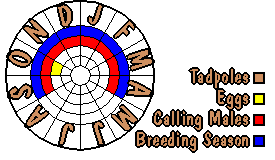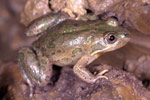Limnodynastes fletcheri
Barking Marsh Frog
Also: Barking Frog, Fletcher's Frog, Long-thumbed Frog

+ 45 kb Barking Marsh Frog (Limnodynastes fletcheri)
A small to moderate frog widespread throughout central and northern New South Wales. In Victoria, the Barking Marsh Frog is largely restricted to the floodplains of the River Murray.
Distribution and habitat

Adults are most often associated with water, in woodlands and river floodplains. Eggs and tadpoles can be found in slow moving or still water, in isolated ponds, dams, lakes, and occasionally rivers.
There is a detailed distribution map available for: Victoria.
Calling
Males call from the water, most often concealed in floating vegetation. The call is a short modulated note, similar to the sound of a distant barking dog and is repeated every few seconds - "whrup".
Copyright Murray Littlejohn. Recorded by Murray Littlejohn. Must not be reproduced without permission.
Life cycle

Distinguishing characteristics
Adult
length: 33-55mm.
Approximately 300 pigmented eggs are contained within a floating foam mass. Tadpoles are yet to be recorded. Adults have large irregularly-edged brown to olive green blotches on the back. They often also have a red or orange patch on the upper eye lid.
Visible features
Presented here is the information stored in the frogs.org.au database which is used to identify frogs based on their appearance. It is intended to be used in a key guide for separating species so some of the information (for example, back colours) may be rather non-specific. The system is currently being developed - if you notice errors in the data, please write to Dave Black at the address at the bottom of the page.
Important note: This information details only the appearance of the frog. If an "or" appears in the description, this may mean either that there is some variation within the species or that the feature might be observed differently by different people. For example, if a frog has very small toe pads, it may be listed as having "Toe pads: present or absent".
Size
Up to between 30mm and 60mm
Eyes, hands, and feet
Pupils: horizontal
Toe pads: absent
Webbing on feet: no webbing
Belly
Texture: smooth
Pattern: plain
Colour: single colour
Back
Texture: smooth or warty
Pattern: spotted or mixed / marbled
Colour: multi-coloured
Glands and tubercles
Parotoid gland: absent
Tibial gland: absent
Metatarsal tubercles: Non-keratinised glands present (fleshy or uncoloured)
Similar species (note: this version was written for Victorian species).
Most often confused with Limnodynastes tasmaniensis - the call is the only real reliable method of identification. The following three methods can be employed with some success: [1] the spots and blotches on the back of L. tasmaniensis tend to be regularly shaped with smooth borders while those of L. fletcheri tend to be irregularly shaped with obscure and fuzzy edges and are often interspersed with dark flecks and peppering; [2] a small red or orange patch on the upper eyelid is often present in L. fletcheri but is extremely rare in L. tasmaniensis; and [3] L. fletcheri usually has a butterfly-shaped blotch between the eyes while in L. tasmaniensis this marking is unlikely to occur.
Limnodynastes fletcheri image gallery
The scientific names of Limnodynastes fletcheri
- Limnodynastes marmoratus (Lamb 1911)
- Limnodynastes fletcheri (Boulenger 1888)


